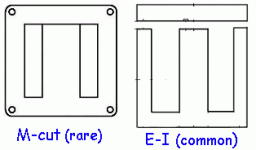...This image seems similar to an assembled EI core.
It has less air-gap.
OTOH, it is very hard to cut that internal slit, you have two pieces of costly scrap, hard to make it minimum-gap without burrs; and you have to bend the tongue with human fingers to fill the bobbin.
E-I has two air-gaps/overlaps per magnetic circuit, but it can be proportioned "scrapless" (the Is are the notches from the Es), and there is a magic machine which stuffs Es and Is like a card-shark shuffling a cut deck of cards.
Attachments
A shield between p and s may sometimes be needed to prevent the frequency response "dip". But, as you rigthly pointed out, it comes at a cost. If you manage to position your secondary in a way that avoids dielectric current flow between primary and secondary then offcourse a shield would make no sense, but this may not always be possible. Offcourse good design will strive for lowest possible dielectric current coupling (BudB philosophy migth be suitable damping, or both, I do not know, I am unable to figure him out) but my impression is that many times ppl can get away without a schield, not because there is no dielectric currentflow between primary and secondary, but because comparable high losses damp the resonance dip enough to be of no concern. Anyway, who wants to exchange a minimal dip in the response curve for the downsides of implementing a shield? In the end, it is all about choices, a shield is just an other tool in the toolboxA screen between P/S is not normally used. It serves no purpose there, whilst possibly increasing inter winding capacitance. (In OPT design folks are often worried about the effect of leakage impedance on h.f. response, neglecting that of inter-winding capacitance. The latter can have the major effect in h.f. where 4 or more secondary sections are used,
Last edited:
